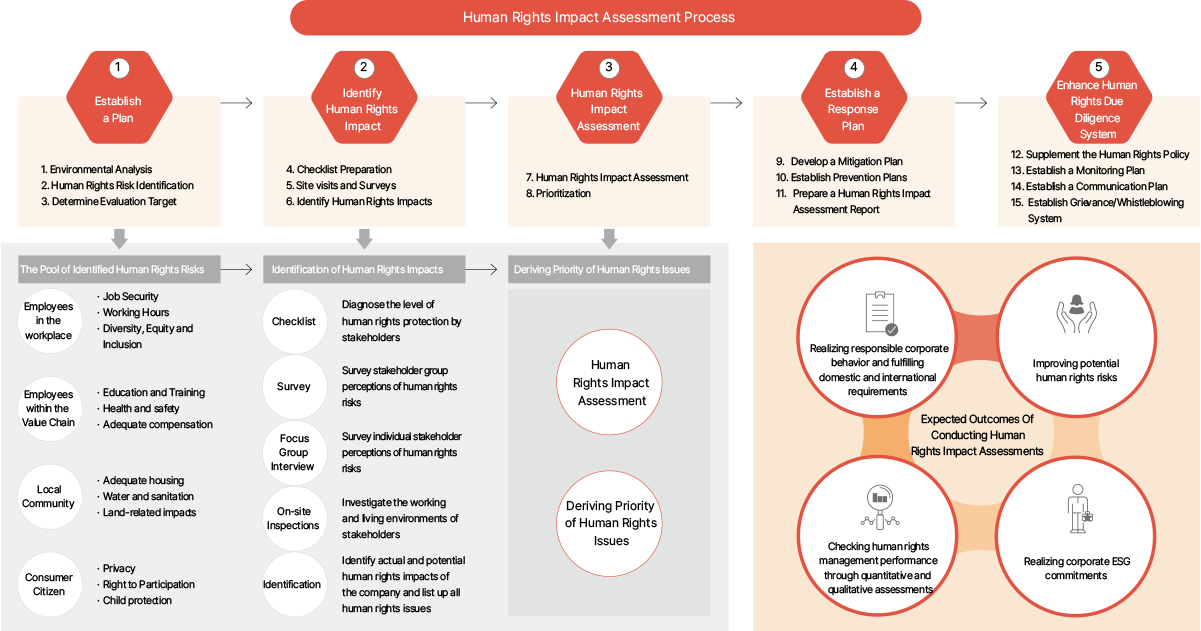2022 Highlights
Human Rights Impact Assesment
Human Rights Impact Assessment
Human Rights Impact Assessment Process
SK bioscience has established a human rights impact assessment process to prevent negative human rights impacts that may arise from the company’s management or business activities and ultimately contribute to the realization of human rights. Through the human rights impact assessment, we will proactively identify and address human rights risks to prevent violations and improve the protection of human rights based on the assessment results.

Step 01 Establish a Plan : Human Rights Impact Assessment Target
SK bioscience conducted a Human Rights Impact Assessment in the first half of 2023 for all employees of the headquarters and Andong L HOUSE to prevent negative human rights impacts. Starting from 2024, we plan to gradually expand the scope of the assessment to include domestic and overseas business sites, suppliers, partners, local communities, and consumers.

Step 02 Identify /Human Rights Impact - 1 : Deriving the Checklist
For the Human Rights Impact Assessment, SK bioscience derived a checklist of 633 indicators suitable for diagnosing major human rights violation factors based on domestic and international human rights-related guidelines, international norms, and domestic laws and regulations.
-
Develop a Draft Checklist
- The Universal Declaration of Human Rights
- The International Covenant on Economic, Social and Cultural Rights, International Covenant on Civil and Political Rights
- The UN Guiding Principles on Business and Human Rights
- ILO Fundamental Conventions
- OECD Guidelines for Multinational Enterprises
- EU Supply Chain Due Diligence Directive
- German Supply Chain Due Diligence Law
- Related domestic laws and regulations
-
Receive Feedback from each Division
- ESG Team Review
- Gather input from relevant and responsible divisions
- Modify and supplement indicators
-
Finalize the Checklist
-
Derive SKBS Human Rights Impact Checklist(633 indicators)
- Human Rights Management System(55)
- Workplace Employees(349)
- Value Chain Employees(52)
- Community(81)
- Consumer/Citizens(96)
-
Derive SKBS Human Rights Impact Checklist(633 indicators)
Step 02 Identify Human Rights Impact - 2 : Identifying human rights issues
We identified actual and potential human rights issues through a checklist of 633 indicators, surveys, focus group interviews(FGIs), and on-site inspections, gathering input on key business indicators.
-
633 Checklist indicators
Workplace Employees, Value Chain Employees, Local Communitie, Consumer/Citizen
-
44 Survey Questionnaires
244 Workplace Employees (Headquarters: 150, Andong L HOUSE: 94)
-
60 FGI participants
- Headquarters: 23
- Andong L HOUSE: 73
-
On-site Inspections
- Headquarters
- Andong L HOUSE
Step 03 Human Rights Impact Assessment : Human Rights Impact Assessment
In the Human Rights Impact Assessment process, the severity and likelihood of actual and potential human rights issues identified in the human rights impact identification stage are evaluated in three stages: low, medium, and high. Severity is judged according to Scale, Scope, and Irremediability, following the UN Guiding Principles on Business and Human Rights. Likelihood is applied as a factor to identify priorities among issues with tied severity ratings.
-
1
Establishing evaluation criteria for prioritiesEstablish detailed evaluation criteria for priorities based on international standards
-
2
Human Rights Impact AssessmentAssess priorities for human rights impacts based on severity and likelihood of occurrence
-
3
Deriving Priorities for human rights issuesCategorize human rights issues into High, Medium, and Low based on priority
Detailed criteria and evaluation methods for Human Rights Impact Assessment
| Criteria | Detailed Criteria | Evaluation Criteria | |
|---|---|---|---|
| Severity | Reference Size |
|
|
| Scope |
|
||
| Irremediability |
|
||
| Likelihood of Occurrence |
|
||
Step 04 Establishing a Response Plan : Establishing a Response Plan for the Human Rights Impact Assessment
Based on the results of the Human Rights Impact Assessment, SK bioscience has prepared a Human Rights Impact Assessment Report that includes improvement tasks and mitigation and prevention plans for each area. Our Human Rights Impact Assessment Report will be publicly disclosed in August 2023.
-
- Mitigation Action Plan
- Prevention Action Plan
-
- Identify mitigation/prevention activities
- Connect relevant divisions/ functions
- Create an activity plan
- Establish a roadmap
-
- 2023 Human Rights Impact Assessment Report
Step 05 Enhancing the Human Rights Due Diligence System : Enhancing the Human Rights Due Diligence System
SK bioscience has strengthened its human rights due diligence system to complement and reestablish its human rights policy. As part of this effort, we have established a monitoring plan and action plan to address the issues identified in the Human Rights Impact Assessment. Accordingly, we will implement a communication plan and human rights education program involving stakeholders. We aim to review and improve the grievance process and whistleblowing system. Furthermore, we plan to establish a task force dedicated to human rights management, working in conjunction with the existing division responsible for addressing human rights-related grievances. We have established a mid-term roadmap to prevent and mitigate major human rights issues identified through the Human Rights Impact Assessment by 2025. Additionally, to ensure sustainable human rights management, we will establish an objective tracking system based on quantitative and qualitative indicators to monitor major human rights issues starting in 2026.

